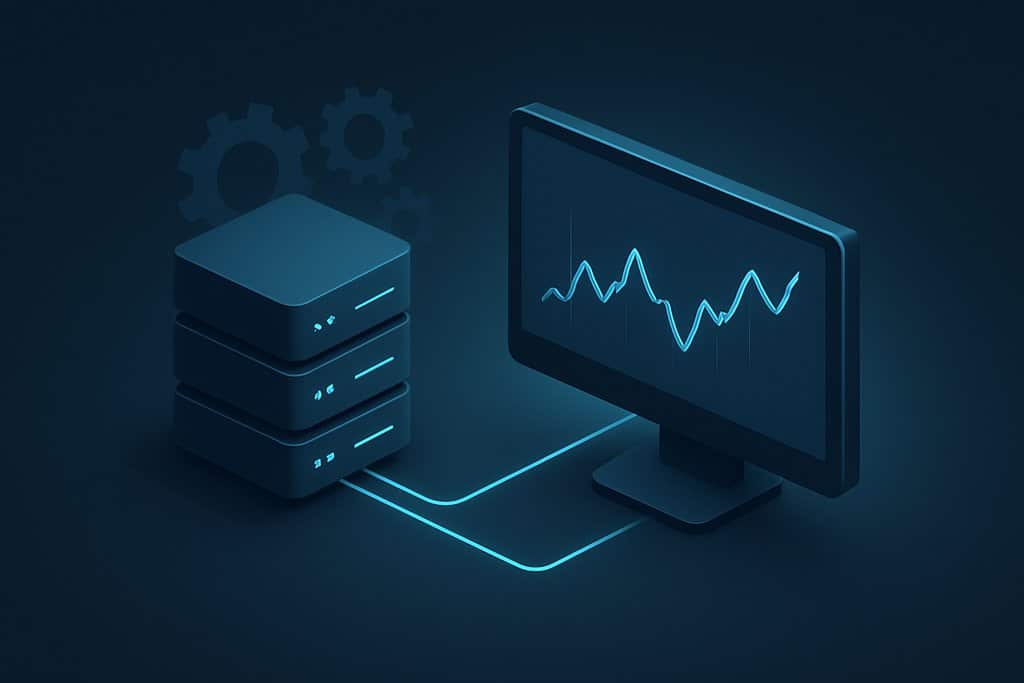Automated Trading Bots: Build, Test, and Deploy Fast
Learn how to design, backtest, and run automated trading bots that execute rules, manage risk, and trade 24/7 across stocks, crypto, forex, and futures.

When markets move faster than you can think, the gap between a good idea and real results is execution. That is why traders look for automated trading bots. They turn rules into reliable actions, cut reaction times to milliseconds, keep discipline under pressure, and trade around the clock without staring at charts.
Whether you trade stocks, crypto, forex, or futures, a well designed bot can monitor signals, place orders, manage risk, and adapt to market conditions with a speed and consistency that is hard to match manually.
On this page
- What are automated trading bots
- How automated trading bots work
- Designing effective bots
- Building a bot with Obside Copilot
- Backtesting and validation
- Operating and maintaining bots
- Use cases
- Benefits and considerations
- Frequently asked questions
- Related articles
What Are Automated Trading Bots?
Automated trading bots are software systems that execute trades based on predefined rules. These rules can be simple, like buy when price breaks above a moving average, or more sophisticated, like multi time frame confirmation with dynamic risk controls and event triggers. The trader designs the logic, the bot monitors data, evaluates conditions, routes orders, and manages positions according to the strategy.
A bot is not the same as high frequency trading, which needs specialized infrastructure and ultra low latency. Most traders use rule based algorithmic trading on minute to daily timeframes, aiming for consistency, risk control, and repeatability rather than raw speed. If you are new to this, see our overview of automated trading to understand core concepts before you build.
How Automated Trading Bots Work
Most bots follow a similar pipeline. Data intake gathers live prices, volumes, and other metrics, and can also include news, social signals, or macro releases. Signal generation transforms raw inputs into features such as moving averages, RSI, MACD, volatility, or event flags, and checks if entry or exit conditions are met.
When conditions trigger, the execution layer sends orders to your broker or exchange using market, limit, stop, or trailing stop orders. Risk management sizes positions, applies stop loss and take profit, caps exposure, and enforces daily loss limits. A monitoring layer handles logging, alerts, error handling, and performance tracking. You need all layers to operate safely and reliably.
Bot performance depends on details. Latency affects fills during fast moves. Slippage can erode edge when signals cluster at crowded levels. Data quality drives signal quality, so address gaps, stale ticks, stock split adjustments, and venue quirks. These are reasons to be deliberate in design and testing, not reasons to avoid automation.
| Layer | Primary role |
|---|---|
| Data | Ingest prices, volumes, events |
| Signals | Compute indicators and rules |
| Execution | Route orders with correct types |
| Risk | Size, stops, limits, exposure |
| Monitoring | Logs, alerts, health, P&L |
Designing Effective Automated Trading Bots
Start with a clear edge and a well defined hypothesis. Are you capturing mean reversion after overbought readings, momentum after breakouts, trend following on higher timeframes, seasonal patterns, or event driven moves after specific news? Your rules should reflect that edge and the timeframe you want to trade.
Technical bots rely on indicators and price action. A simple momentum bot might buy when price closes above a 50 period moving average with RSI above 55, and exit if RSI falls below 50 or a trailing stop hits. A multi factor approach could combine Supertrend on 2 hour and 8 hour charts, allow entries only when both are bullish, ensure RSI is not overbought, apply a 5 ATR trailing stop, and reverse logic on trend change.
Event driven bots respond to news or macro data, such as buying oil when a hurricane is declared in the Gulf of Mexico or reducing exposure when tariffs hit a key sector. You can also mix signals, for example buy crypto when daily volume doubles and price breaks a key level if broad risk appetite is supportive. For crypto specific workflows, see our guide to an AI crypto trading bot.
When the Supertrend becomes bullish on the 2h chart, if RSI is not overbought and the Supertrend on the 8h chart is also bullish, then buy. For selling, reverse the logic and place a trailing stop at 5 ATR (2h). Close if the 2h Supertrend flips.
Building a Bot Step by Step with Obside Copilot
Many traders stall because setup feels complex. With Obside you can go from idea to live in minutes. Write your objective in plain language inside Obside Copilot, for example: I want a momentum bot on Bitcoin that buys when price closes above the 200 period moving average and daily volume is at least 2 times the 30 day average, with a stop at yesterday’s low and a 10 percent take profit. Copilot drafts the rules and shows inputs.
Refine signals and risk. Add filters like trade only during high volume sessions or avoid entries near major releases. Add dynamic sizing such as allocate 2 percent of equity per trade or cap portfolio exposure at 50 percent. Encode how you would manage this strategy manually, then let the bot execute consistently.

Backtest instantly with Obside’s ultra fast engine. The platform runs your bot on historical data and returns core metrics in seconds. Review win rate, profit factor, Sharpe, drawdown, average trade duration, exposure, and slippage assumptions. If you see overfitting, simplify rules or expand the window. If exits lag, adjust stops or add time based exits. See also our primer on paper trading before you go live.
Flip to simulation for live validation, then connect your broker or exchange and switch to production. Obside supports smart alerts, automatic orders, and full portfolio rules, so you decide how hands off to be.
Monitor and iterate in the dashboard. Watch fills, open risk, and performance by rule. Add alerts if daily drawdown exceeds a threshold or if signals stop firing. Because Copilot speaks human language, you can evolve logic quickly. For a broader overview, read our trading bot guide.
Backtesting and Validation for Automated Trading Bots
Backtesting separates a convincing story from a statistically robust strategy. Clean data is step one. Adjust for stock splits and dividends, use venue specific data for crypto when possible, include delisted symbols for cross sectional tests, and set realistic commissions and slippage. For a primer on slippage, see Investopedia.
Split data into in sample and out of sample. Fit parameters on the first segment, then validate on the second. Walk forward analysis repeatedly re calibrates on a rolling window and tests on the next period to evaluate stability.
Watch for overfitting. Prefer simple rules with clear rationale and use parameter ranges rather than single magic numbers. Stress test by degrading signals, widening spreads, or inserting data gaps. Aim for a bot that holds up under pressure.
Backtest to separate story from statistics, then validate forward before risking capital.
Monte Carlo resampling can estimate the range of outcomes given your trade return distribution, which informs drawdown and time to recovery expectations. Finally, forward test in paper mode to catch real time issues that backtests can miss, like delayed timestamps or exchange specific quirks.
Obside helps by running fast backtests, enforcing walk forward validation, and letting you compare live paper results to history side by side. The speed encourages disciplined testing, not cherry picking.
Operating and Maintaining Your Trading Automation Bots
Running a bot is not set and forget. Establish risk budgets. Cap position size, daily loss, and portfolio drawdown. Implement circuit breakers that pause trading if volatility exceeds your threshold or if errors stack up. Many intraday traders close positions by end of day to avoid overnight risk.
Monitor latency and slippage, especially around news. If fills are sensitive, adjust order types, use limit orders with protective stops, or widen entry filters to avoid chasing price. Keep detailed logs for decisions. This supports post trade analysis and prevents guesswork.

Plan for connectivity and API issues. Handle retries, verify order acknowledgments, and reconcile positions with your broker. Cloud platforms like Obside manage infrastructure and connections so you can focus on strategy logic.
Treat your bot like software. Version strategies, track changes, and change one variable at a time. Create a release checklist for production updates to prevent regressions and maintain consistency.
Use Cases: From Simple Alerts to Full Automated Strategies
Start with a specific problem. Precise alerts ensure you never miss a setup: alert me if Bitcoin rises above 150,000 and daily volume doubles, or notify me if RSI crosses 70 on EUR/USD and MACD turns bearish. On Obside, these are one line instructions in Copilot.
Automate actions around events: buy 50 dollars of Tesla if Elon Musk tweets about it, sell all positions if the S&P 500 drops by 10 percent, or buy 1,000 dollars of Bitcoin if price dips below 100,000. These are not recommendations, they show how to encode rules you believe in.
Graduate to full strategies. For example, buy when there is a bullish RSI divergence on a 15 minute chart, set a stop at the low of the day, take profit at 10 percent, and add a 5 ATR trailing stop. Or run a portfolio rule that keeps 50 percent BTC, 25 percent ETH, and 25 percent USDC with rebalancing when weights drift by more than 5 percent. If you focus on equities, see our guide to an AI stock trading bot.
- Alert me if Bitcoin rises above $150,000 and daily volume doubles.
- Notify me if RSI crosses 70 on EUR/USD and MACD turns bearish.
- Buy $50 of Tesla if Elon Musk tweets about it.
- Keep 50% BTC, 25% ETH, 25% USDC and rebalance on 5% drift.
Benefits and Considerations of Automated Trading Bots
- Removes emotional bias and decision fatigue
- Runs 24/7 and watches many markets at once
- Executes rules consistently for statistical edge
There are considerations too. Overfitting can ruin live performance. Market regimes change, and last year’s edge can fade. Slippage and fees can turn theoretical edge into a marginal one. Data outages or API changes can cause surprises if not handled. Automation amplifies both good and bad decisions, so build testing, risk controls, and monitoring into your process. For a broader perspective on tools, see our overview of AI trading software.
Obside mitigates many risks with fast backtesting, paper mode, broker connectivity, and a natural language interface that reduces implementation errors. It cannot guarantee profits, but it can shorten the path from idea to reliable execution.
Frequently Asked Questions
How much capital do I need to start?
You can start small. Many brokers and exchanges support fractional shares or small crypto orders. Size positions so that fees and slippage do not dominate. Begin in paper mode, then go live with small size and scale as your bot proves itself.
Do automated trading bots work for beginners?
Yes, if you keep rules simple and focus on learning. Start with one market and one timeframe, add clear risk limits, and backtest before going live. Platforms like Obside make setup easier by converting plain language rules into working bots. The goal is consistency, not complexity. For step by step guidance, read our trading strategy guide.
Are crypto bots different from stock or forex bots?
Core principles are the same. Crypto trades 24/7 with different liquidity patterns and higher volatility, so you may need wider stops and round the clock monitoring. Stocks have market hours, corporate actions, and earnings events. Forex follows global sessions. Adapt your rules to each market’s microstructure and keep your testing discipline unchanged.
How do I avoid overfitting?
Use simple rules with economic rationale, validate out of sample, run walk forward tests, and apply realistic costs. If small parameter tweaks swing results wildly, the edge may not be robust. Favor stability over peak backtest returns.
What is the best platform to build a bot?
Choose a platform that lets you express ideas quickly, backtest fast, connect to brokers, and run live reliably. Obside excels at this flow because you can describe rules in natural language, validate in seconds, and automate alerts, orders, or full portfolios across assets. Try it at beta.obside.com.
Conclusion: Turn Your Ideas Into Automated Execution
Define your edge, encode rules, validate with rigorous testing, then execute with discipline. Start with one focused idea, build it in Obside Copilot in plain language, backtest in seconds, run in paper mode, then go live with controlled risk. Once your workflow is in place, iterate and expand with confidence.
